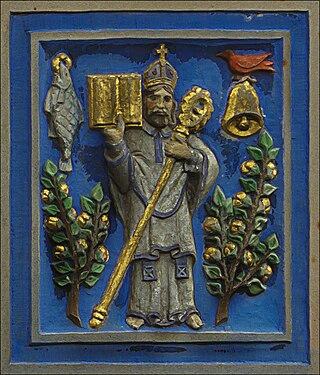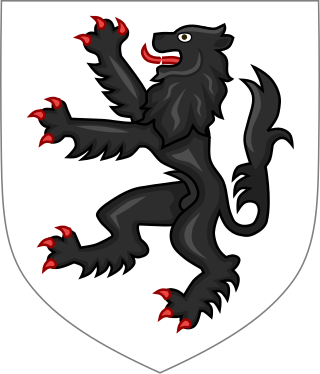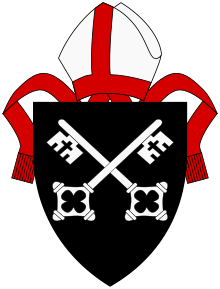
Kentigern, known as Mungo, was a missionary in the Brittonic Kingdom of Strathclyde in the late sixth century, and the founder and patron saint of the city of Glasgow.

St Asaph is a city and community on the River Elwy in Denbighshire, Wales. In the 2011 Census it had a population of 3,355, making it the second-smallest city in the United Kingdom in terms of population and urban area. It is in the historic county of Flintshire.
Thomas Goldwell was an English Catholic clergyman, Bishop of Saint Asaph, the last of those Catholic bishops who had refused to accept the English Reformation.

Saint Deiniol was traditionally the first Bishop of Bangor in the Kingdom of Gwynedd, Wales. The present Bangor Cathedral, dedicated to Deiniol, is said to be on the site where his monastery stood. He is venerated in Brittany as Saint Denoual. In English and Latin his name is sometimes rendered as Daniel.

The Diocese of Saint Asaph is a diocese of the Church in Wales in north-east Wales, named after Saint Asaph, its second bishop.

Saint Asaph was, in the second half of the 6th century, the first Bishop of St Asaph, i.e. bishop of the diocese of Saint Asaph.

The Bishop of Bangor is the ordinary of the Church in Wales Diocese of Bangor. The see is based in the city of Bangor where the bishop's seat (cathedra) is at Cathedral Church of Saint Deiniol.

The Diocese of Chester is a Church of England diocese in the Province of York covering the pre-1974 county of Cheshire and therefore including the Wirral and parts of Stockport, Trafford and Tameside.

Madog ap Gruffudd, or Madog ap Gruffudd Maelor, was Prince of Powys Fadog from 1191 to 1236 in north-east Wales, and Lord of Powys. He was the founder of Valle Crucis Abbey, in the lordship of Yale.

The Diocese of Wrexham, is a Latin Church ecclesiastical territory or diocese of the Catholic Church in Wales. The diocese is a suffragan in the ecclesiastical province of the metropolitan Archdiocese of Cardiff.

The Abbey of Strata Marcella was a medieval Cistercian monastery situated at Ystrad Marchell on the west bank of the River Severn near Welshpool, Powys, Wales.

The Cathedral Church of Saints Asaph and Cyndeyrn, commonly called St Asaph Cathedral, is a cathedral in St Asaph, Denbighshire, north Wales. It is the episcopal seat of the Bishop of St Asaph. The cathedral dates back 1,400 years, while the current building dates from the 13th century. The cathedral is part of the Church in Wales and part of the Anglican Communion of Wales.

Llanllugan Abbey was a monastery of Cistercian nuns, one of only two Cistercian women's monasteries in Wales, located at Llanllugan, Powys, Wales. An early charter to Llanllugan nunnery was issued by Maredudd ap Rhobert, Lord of Cedewain, probably some time in the early thirteenth century. Maredudd's charter provided the nuns with their core estates in the township of Llanllugan between the two streams of the Rhiw. The abbey's other estates include Hydan grange in Castle Caereinion and Cowney in Llangadfan. Llanllugan also received income from appropriated churches, the rectory of Llanfair Caereinion was granted by Bishop Hugh of St Asaph in 1239 and Llanllwchairan by Bishop Anian of St Asaph in 1263. It was founded as a dependency of the Cistercian monks at the Abbey of Strata Marcella. The former monastery church survives as the parish church of Llanllugan. However, the site of the abbey buildings remains uncertain: they might have been in a meadow 200 metres to the south of the church.
This article is about the particular significance of the century 1201–1300 to Wales and its people.
This article is about the particular significance of the century 1101–1200 to Wales and its people.

The history of Gwynedd in the High Middle Ages is a period in the History of Wales spanning the 11th through the 13th centuries. Gwynedd, located in the north of Wales, eventually became the most dominant of Welsh polities during this period. Contact with continental courts allowed for Gwynedd to transition from a petty kingdom into an increasingly sophisticated principality of seasoned courtiers capable of high level deplomacy and representation; not only with the Angevine kings, but also the king of France and the Papal See. Distinctive achievements in Gwynedd include further development of Medieval Welsh literature, particularly poets known as the Beirdd y Tywysogion associated with the court of Gwynedd; the reformation of bardic schools; and the continued development of Cyfraith Hywel. All three of these further contributed to the development of a Welsh national identity in the face of Anglo-Norman encroachment of Wales.
Culture and Society in Gwynedd during the High Middle Ages refers to a period in the History of Wales spanning the 11th, 12th, and 13th centuries. The High Middle Ages were preceded by the Early Middle Ages and followed by the Late Middle Ages. Gwynedd is located in the north of Wales.
Bleiddud was Bishop of St David's in Wales from 1061 to 1071. Little is known of him. His name is sometimes given as Bedwd.
A clas was a native Christian church in early medieval Wales. Unlike later Norman monasteries, which were made up of a main religious building supported by several smaller buildings, such as cloisters and kitchens, a clas was normally a single building. The building was run by a community of clergy and headed by an abod. Clasau were autonomous and were administered locally.
Dafydd ab Owain was a Welsh abbot and bishop. His family were from the Glasgoed area of Meifod, Powys. He studied at Oxford, graduating with a qualification in canon and civil law. He is thought to have taken his doctorate in law.





































